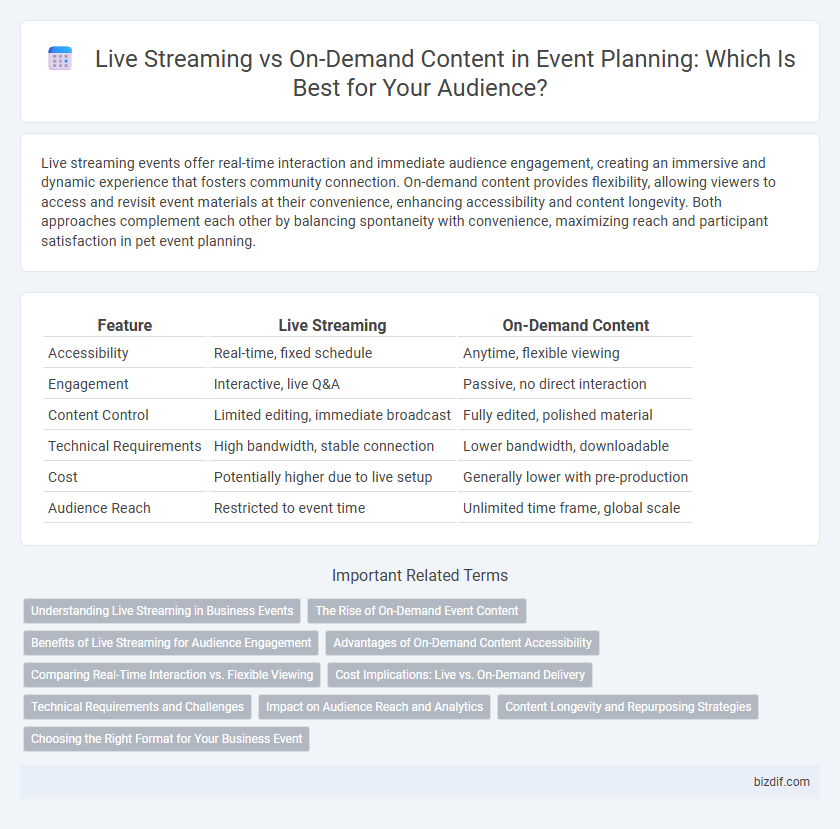Live streaming events offer real-time interaction and immediate audience engagement, creating an immersive and dynamic experience that fosters community connection. On-demand content provides flexibility, allowing viewers to access and revisit event materials at their convenience, enhancing accessibility and content longevity. Both approaches complement each other by balancing spontaneity with convenience, maximizing reach and participant satisfaction in pet event planning.
Table of Comparison
| Feature | Live Streaming | On-Demand Content |
|---|---|---|
| Accessibility | Real-time, fixed schedule | Anytime, flexible viewing |
| Engagement | Interactive, live Q&A | Passive, no direct interaction |
| Content Control | Limited editing, immediate broadcast | Fully edited, polished material |
| Technical Requirements | High bandwidth, stable connection | Lower bandwidth, downloadable |
| Cost | Potentially higher due to live setup | Generally lower with pre-production |
| Audience Reach | Restricted to event time | Unlimited time frame, global scale |
Understanding Live Streaming in Business Events
Live streaming in business events enables real-time interaction and immediate audience engagement, creating a dynamic platform for brand messaging and networking. It leverages high-quality video and audio to broadcast conferences, product launches, and webinars directly to a global audience, enhancing accessibility and participation. Integrating live streaming with analytics tools provides actionable insights into viewer behavior and event impact, optimizing future event strategies.
The Rise of On-Demand Event Content
On-demand event content has surged in popularity due to its convenience and accessibility, allowing attendees to engage with event materials anytime and anywhere. This format supports deeper audience engagement by enabling viewers to pause, rewind, and revisit sessions, enhancing knowledge retention and satisfaction. Platforms like Vimeo and YouTube have driven this trend by offering robust hosting and monetization options tailored to event organizers.
Benefits of Live Streaming for Audience Engagement
Live streaming enhances audience engagement by offering real-time interaction, creating a sense of immediacy and connection that on-demand content lacks. Interactive features like live chat, polls, and Q&A sessions foster active participation, making viewers feel involved and valued. This immediacy drives higher retention rates, increased social sharing, and a stronger community around the event.
Advantages of On-Demand Content Accessibility
On-demand content enhances event accessibility by allowing attendees to view sessions anytime and anywhere, removing geographical and time zone barriers. This flexibility supports diverse schedules, increasing overall engagement and reach. On-demand videos also enable repeated viewing, helping participants fully absorb and revisit important information at their convenience.
Comparing Real-Time Interaction vs. Flexible Viewing
Live streaming enables real-time interaction by allowing attendees to engage instantly through Q&A sessions, polls, and chat features, enhancing audience participation and immediacy. On-demand content offers flexible viewing, letting participants access event materials at their convenience, which increases accessibility and accommodates different time zones. Choosing between the two depends on whether prioritizing dynamic engagement or personalized, time-independent consumption is more valuable for the event goals.
Cost Implications: Live vs. On-Demand Delivery
Live streaming incurs higher costs due to the need for real-time encoding, dedicated bandwidth, and technical support during the event, increasing overall expenses. On-demand content reduces costs by allowing pre-recorded editing and distribution without requiring continuous streaming resources. Event planners must weigh these differences to optimize budgets while delivering quality content to their audience.
Technical Requirements and Challenges
Live streaming demands robust internet connectivity, high-performance encoding software, and real-time content delivery networks to minimize latency and buffering issues. On-demand content requires secure hosting platforms, efficient video compression, and adaptive bitrate streaming to ensure smooth playback across diverse devices and network speeds. Both formats face challenges like content protection, user engagement optimization, and integration with event management systems.
Impact on Audience Reach and Analytics
Live streaming significantly expands audience reach by enabling real-time interaction and engagement across global locations, enhancing the sense of immediacy and community. On-demand content provides extended accessibility, allowing viewers to consume material at their convenience, which increases overall viewership and retention rates. Analytics from live streams offer immediate insights into viewer demographics and behavior, while on-demand analytics provide long-term data on viewer preferences and content performance, facilitating strategic event planning.
Content Longevity and Repurposing Strategies
Live streaming creates real-time engagement but has limited content lifespan, making it essential to capture and repurpose key moments for extended use. On-demand content offers prolonged accessibility, enhancing content longevity through flexible viewing and multiple repurposing opportunities across platforms like social media, websites, and email campaigns. Strategic editing and segmenting of both formats maximize audience reach, SEO benefits, and return on investment in event content.
Choosing the Right Format for Your Business Event
Live streaming offers real-time audience engagement and immediate feedback, making it ideal for interactive business events like product launches or webinars. On-demand content provides flexibility for attendees to view sessions at their convenience, enhancing accessibility and extending the event's lifespan. Evaluating your target audience's preferences and event objectives ensures selecting the most effective format for maximizing reach and impact.
Live streaming vs On-demand content Infographic

 bizdif.com
bizdif.com